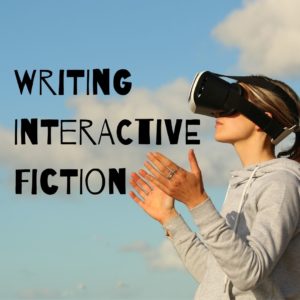 I’m hoping eventually to have the bulk of the Rambo Academy for Wayward Writers classes up as on-demand versions, but it’s slow going. I’m so delighted that Kate Heartfield has turned her awesome Writing Interactive Fiction live class into an on-demand version and she’s very generously suggested making it free this first week in order to offer another resource for folks practicing social isolation to entertain and educate themselves.
I’m hoping eventually to have the bulk of the Rambo Academy for Wayward Writers classes up as on-demand versions, but it’s slow going. I’m so delighted that Kate Heartfield has turned her awesome Writing Interactive Fiction live class into an on-demand version and she’s very generously suggested making it free this first week in order to offer another resource for folks practicing social isolation to entertain and educate themselves.
I book teachers for classes that I personally want to take, and this was definitely one of them. After the first time Kate taught this class, I felt inspired to start noodling around with an interactive novel, although I’m still very much in the planning stages.
Here’s a link for the new class.
If you’ve ever found yourself choosing between possible endings or plot twists, why not try a storytelling format that lets you explore them all? Games and interactive fiction invite the reader to join in the storytelling process, and invite the writer to consider multiple facets of agency, characterization, pacing and plot. Learn some fundamental principles and techniques for interactive formats, or just gain a new perspective on ways to develop your non-interactive prose.
 Kate Heartfield is the author of two interactive novels for Choice of Games: The Road to Canterbury, which was published in 2018 and shortlisted for the first Nebula award in the game writing category; and The Magician’s Workshop, published at the end of 2019. She is also the author of the historical fantasy novel Armed in Her Fashion, which won the Aurora Award for Best Novel and was shortlisted for the Locus First Novel, Crawford and Sunburst awards. Her two Alice Payne time travel novellas were shortlisted for the Nebula and Aurora awards. A former newspaper journalist, Kate lives in Ottawa, Canada.
Kate Heartfield is the author of two interactive novels for Choice of Games: The Road to Canterbury, which was published in 2018 and shortlisted for the first Nebula award in the game writing category; and The Magician’s Workshop, published at the end of 2019. She is also the author of the historical fantasy novel Armed in Her Fashion, which won the Aurora Award for Best Novel and was shortlisted for the Locus First Novel, Crawford and Sunburst awards. Her two Alice Payne time travel novellas were shortlisted for the Nebula and Aurora awards. A former newspaper journalist, Kate lives in Ottawa, Canada.
If you’d prefer to take a live version in which you have a chance to talk with Kate, she is teaching it on Saturday, April 11, 2020, 1:00-3:00 AM Pacific time.
Live versions of the classes are performed in realtime, are limited to 15 students, and include a chance to interact with the instructor as well as a recording of the class. You can find the current list of upcoming live classes through June here. There are free scholarship slots available in every class.




